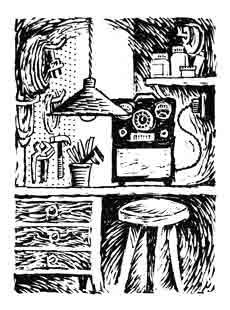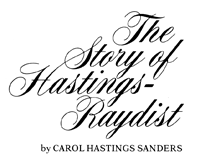I
've just rented a Post Office Box in the name of the Hastings Instrument Company, so I guess we're in business," Charles told Mary happily. It was September 8, 1944. The following week Mary ordered some business stationery. The dream was beginning to take shape.
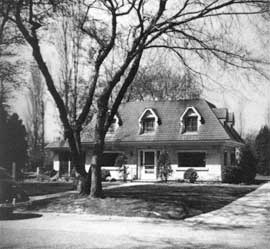
The Hastings home, 117 Hampton Roads Avenue.
|
From outward appearances, the fledgling company was not impressive. The place of business was simply a workshop in the back of the Hastings home. For several weeks they didn't even get around to setting up a company checking account. When they did, they found that their initial deposit of $210 lasted them until December. There were no paid employees, only a few friends who came to the house several evenings a week after their regular jobs. During "normal" business hours, the only one there was Mary, who squeezed in various company projects while taking care of the house and two small children.
However meager the appearances, there was an abundance of ideas, determination, and enthusiasm. And a long list of projects to get under way. As often as possible, Charles took off a few days from the NACA to meet with prospective customers.
Work progressed well. In November he hired two men to spend a few hours each week helping him to construct models. By Christmas he had received his first contract—an $800 order from the Naval Aircraft Factory in Philadelphia, which wanted a rotary magnetic switch for commutating electrical circuits. By January he had built his first heated thermopile anemometer. He decided to call it an Air-Meter.
The Air-Meter was based partly on the ideas he had had in 1940 for making a thermopile instrument to measure aircraft speed. It also incorporated his later invention of a way to make a thermopile compensated for both temperature and rate of change of temperature.
He decided to name his radio ground speed system by wedding the first syllables of the words "radio" and "distance" to form the acronym "Raydist."
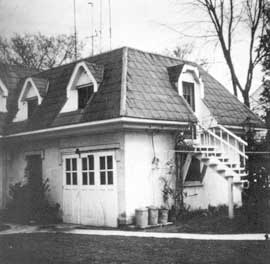
From 1944 to 1947, the Hastings Instrument Company occupies a converted garage and an upstairs apartment in the back of the Hastings home.
|
In early February 1945 he was so encouraged by the prospects for his company that he decided to expand. He had more work than he could handle, and it looked as if several of the ideas were going to pay off. It was time to get some additional capital so that he could buy the materials and labor he needed to really get things going.
His own finances were already stretched thin; he would have to borrow the money. A couple of people had already offered to lend him money, but he preferred to borrow it within the family. He would ask his father.
He realized, however, that his father was very conservative with money. To say that his father frowned on people who went into debt was an understatement. Charles had gone through this with him before, when he had wanted to borrow money to buy the house. His father had told him in great detail how bad it was to borrow money. But when Charles said he was going to do it anyway, his dad had agreed to make the loan. This time, he felt sure, would be no different. He would get a lecture about the dangers of taking risks and borrowing money, but in the end his father would back him up.
Confident that the money would be available, he ordered his supplies and increased the number of paid employees to nine.
On February 10, he and Mary began an exchange of letters with his father about a loan. In retrospect, those letters are important not for what they said about the loan, but for what they reveal about Charles Hastings, his attitudes toward his new venture, and his attempts to get it under way.
Mary began with a special request, that Charles's father, who was in the plumbing business, find materials for them:
Dear Mother and Dad,
It is very late (as usual) but Charles wants you, Pop, to try and see how much of the material on the enclosed list you can locate and have sent down as soon as possible. Tell them he will send a confirmation with AA2 Priority and a check, or they can send it C.O.D.
She went on to tell them about their grandson, who had been sick, and about a minor accident with the car. Then Charles took over:
Pop,
The items marked are needed for my Navy contract. I would really like to get this stuff by Wednesday night so if you could get the stuff on the Old Bay Line I would greatly appreciate it. The Navy wants these relays I am building by the last day of February so I must get to work fast. I want to make a good showing on my first Navy contract.
The letter continues a little longer, and then concludes:
An investment of $1000 this month and another $1000 in about a month would help a lot if you could spare it.
Your loving son, Charles
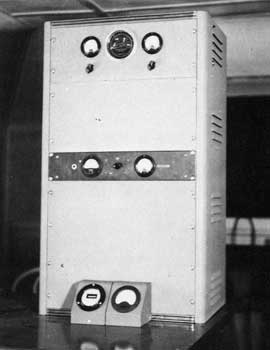
A prototype Raydist sits on a table in the upstairs apartment.
|
The reply was immediate and predictable. The elder Mr. Hastings was appalled by his son's decision to start his own business, and even more appalled by his son's willingness to finance that business with borrowed money:
… It is often a disgrace to borrow. It leads to making a financial wreck of many people. I did not do it and never intend to do so. I cannot see how you can need so much money. Why can't the profit, if there is any and I doubt there is, take care of the expense? Manufacturing is out of your line. You have never had that experience. You are theorizing and gambling…. I shall not be surprised if you get in trouble at the field with NACA or in financial difficulty. You certainly have no right to sacrifice your salary, your home, and go into debt with the children to look after.
Charles, your credit references would mean very little to a credit manager. You are a raw product—you have not had time to establish a debt-paying reputation. You are only a moral risk to credit men and if not careful you may be a black mark on credit pages for the rest of your life…. Remember home and name in life. The sum you mention is terrible, and on an uncertain proposition. If the war stops suddenly, you would not get an item to sell, just like after War #1.
But undoubtedly he knew that his son would not be dissuaded. The letter continues:
What are your plans on how to use this vast sum? Write more fully and explain. Give me concrete figures …. I will write more when I hear from you.
Father
Charles replied on February 19. He thanked his father for helping him to get the supplies he needed, then described his current operations:
I have expanded somewhat my operations beyond the point when you were here last, and I have a dozen employees now. The costs of labor and materials is running approximately $100 a week. We are constructing a single unit of an accelerometer at the request of the Air Technical Service Command at Wright Field. Also we are constructing six deflectometers at an approximate total cost of $250 which we plan to send to several Army and Navy Departments as samples. I personally have not the slightest doubt but that I will get my money out of these deflectometers, and I feel it is quite likely that I may obtain large orders, in which case we plan to sub-contract all the parts and just assemble the instruments here. We are also constructing an accelerometer calibrator of which the cost is probably about $50. All this, and we are spending a lot of time (man-hours at $1.00 an hour) in making preliminary designs and estimates for contracts which we expect to get from the NAF [Naval Aircraft Factory].
It is true that going into any business venture is a gamble in some respects and that nothing in this life is certain, but I feel that few people are in a position such as myself with such good opportunities to succeed. I realize that you have always been very conservative, and that you may not feel that this venture is wise, and I don't want to put you in a position in which you feel that you have to lend me the money because I have several other sources from which I am certain that I can secure the money. (Two people have already offered financial assistance unsolicited.) Andrew Hacskaylo told me without my even mentioning the subject, that he would like to put several thousand dollars into the business. I don't know exactly what he would expect in return. However, since we are certain that we can obtain the money from one of these several sources, we have gone right ahead with our plans. We will not feel badly toward you in the slightest if you do not feel you want to get into this venture. We will need money before March 1, though, to take care of bills and pay checks due that date, so if we don't hear from you next week we will have to borrow the money from one of these other sources. Our income is also reduced by the fact that we needed to take over the apartment for office and assembly space. We are trying to save where possible, and it is much cheaper to get the required space in this manner than to hire a building somewhere.
We would love to have you come down anytime you can.
Love,
Charles
Feb. 24, 1945
Dear Charles and Mary,
I have carefully read your letter and fail to see a glimmering of hope of a profit from your gamble, and as the letter continues there is increasing cause for worry that you are in grave danger of losing your home and getting a black mark on your career. But this does not seem to cause you any concern.
… I am going to send a check for one thousand dollars to get you out of debt and if then you still want to go broke, I am not going broke with you.
Wake up before it is too late.
Father
March 3, 1945
Dear Pop,
I feel that your objections may be similar to those expressed when I bought this house and are made so strong to emphasize a point. However, if I really thought you really meant all you said I would give it back. Anytime you feel that you need the money … I assure you I can arrange to pay you back.
My organization is not an ordinary group, my work and projects are not easily explained. Some are confidential. However, I am certain I can get the organization totally outside financed, but that would require incorporating—leaving the field and working full time. I definitely do intend to leave the field, but the way I am doing it, this way I will be completely on my feet before I leave. I assure you all my bosses would hate to see me leave and give me my job back at any time. If I could get a release now I could get a dozen jobs at more money. The only man who has to worry about his job is the one who is not worth the money he receives. If I was in the latter class I would want to get kicked out.

from a letter by Charles Hastings to his father, March 3, 1945
|
Incidentally, Benson is working with me now. His father-in-law has the largest machine shop in this area which may be of assistance to us. You may worry about this company but few who know the insides of the company doubt my ability to put it over.
Your loving son,
Charles

Charles Hastings (left) watches Raydist heterodyne tone on cathode ray oscilloscope while Ray Hansen makes notes.
|
A
nd so the Hastings home took on more and more a dual life. During the day, two small children played in the yard, and the home looked just about like any other home in the neighborhood. The only clue that this home was perhaps unusual was the large number of antennas sticking up from the roof. But the daytime appearances were deceiving. At 7 p.m. every Monday, Wednesday, and Friday evening a transformation took place, as up to seventeen employees turned up to work on their electronic projects.
The place was a beehive of activity that summer. Raymond Hansen and Thomas Carpini were designing tachometers and latching relays. Jim Benson and John Brockett were busy with the magnetic switch project. Andrew Hacskaylo was working on a "strobospeed"; Emmanuel Schnitzer, the Air-Meter; Harry Ricker, Jr., an electric micrometer; and Bunny Helfand, a visibility meter. Albert Budde was preparing Raydist and Air-Meter patent applications.
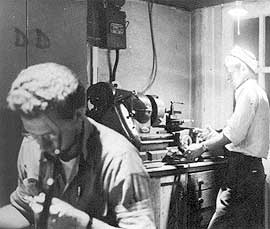
In the converted garage, Pete Ianuzzi assembles experimental equipment while machinist G. H. Jenkins works at a lathe.
|
Peter Ianuzzi and G. H. Jenkins handled construction at the Hastings home. Other construction jobs were contracted out to Sumner Besse, Charles Folk, and Stanley Brigham, who had small workshops of their own. Mary Hastings handled the paperwork, wrote letters, edited reports, and supervised purchasing agent Hugh Watson, accountant Walter Chapman, and secretary Althea Hansen.
In addition to overseeing everyone else's projects, Charles Hastings worked on his Raydist equipment and tried to line up contracts for his company.
Eventually the work took up more and more of the home. When the apartment became too crowded, the business invaded the rest of the house. A drafting table was set up in the kitchen, and a card table for bookkeeping and typing was set up in the living room. Mary's oven was used to bake the "black crackle" paint finish on the cases of electronic equipment.
Theoretically work ended at 11, but in practice it ended whenever people came to a good stopping point, whether at 10 or at midnight. Then everyone would gather around the dining room table and discuss the evening's work over hot and cold drinks, sandwiches, and other light refreshments.
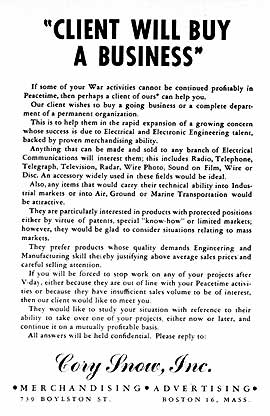
Looking for companies to manufacture his products, Charles Hastings replies to this ad in the June 1945 issue of Electronic Industries magazine.
|
D
uring the day, while the others worked at their regular jobs, Mary took care of miscellaneous projects.
Making blueprints was one of her specialties. A person needing a blueprint gave his drawing to Mary, crossed his fingers, and hoped for clear weather. The next morning, using only the sunlight coming through the kitchen window, Mary would make the blueprint and have it ready by that evening.
One day while Charles was still working days at the NACA, Mary agreed to have some Raydist cabinets painted for him by the time he came home. Then she discovered that the compressed air tank was empty. Undaunted, she got into her car, drove to a nearby service station, put as much air into the tires as she dared, and drove back home, hoping to get there without a blowout. She then attached her paint sprayer to the tires and painted until each tire was almost flat. It took several refills at the service station, but by the time Charles got home, his cabinets were painted.
All this activity took its toll on the house, especially the roof. The roof was drilled for mounting antennas, and many of the mountings leaked. During one heavy storm the roof leaked so badly that the ceiling of one room was ruined. Eventually the constant mounting of antennas had damaged the roof so thoroughly that the entire roof had to be replaced. The cinder driveway was unable to stand up to the delivery trucks that came to the home, and was replaced with one of concrete. And Mary was not overjoyed that her oven always smelled like paint when she tried to cook dinner. But the important thing was that the business kept going.
I
n addition to working on the few contracts he received and touting the potential of Raydist to anyone who would listen, Hastings kept his eye out for companies that might buy the rights to manufacture the products he was developing.

This ad for the resonant relay developed at Hastings Instrument Company appears on the pages of trade journals in 1946.
|
He found a promising advertisement in the June 1945 issue of Electronic Industries magazine, and sent off an inquiry.
Soon he was in contact with Ezra Stevens of the Stevens-Arnold Company of Boston, Massachusetts. Stevens-Arnold had started in 1943 to manufacture war parts under military contracts. With the end of the war in sight, Stevens foresaw that in the near future he would have a production facility with 100 employees and nothing to produce. He was looking for products.
After an initial exchange of letters, Hastings flew to Boston to talk with him. They discussed several of Hastings' products, and soon afterwards Stevens came down to Hampton. Since Hastings had no plans to be a manufacturer himself, he was willing to sell the rights to any of his ideas—magnetic switches, Raydist, Air-Meters, or whatever—on the right terms. He put everything on the table.
Within two months they had agreed for Stevens to produce the magnetic switch. As part of the agreement, Hastings and Benson would come to Boston from time to time to help work out the bugs in getting production under way. Later they agreed for Stevens to produce the electric micrometer and a resonant relay as well. Although Raydist, the thermopile Air-Meters, and other ideas were discussed, no agreements were ever reached, and those items remained with the Hastings Instrument Company.
T
he combination of the Stevens-Arnold deals and the promotion of his other products meant that Hastings was seldom home in the fall of 1945. Whenever he wasn't in Boston, helping Stevens, he was in Washington, New York, Cleveland, Buffalo, Philadelphia, Pittsburgh, or wherever, making a sales pitch.
At the end of January, 1946, he resigned from the NACA to devote 100 per cent of his time to the company. And finally, in March, he received his first Raydist contract. After being turned down or put off a documented one hundred and three times, he had finally convinced someone to say "Yes." The Air Material Command at Wright Field in Cleveland, Ohio, wanted a single-dimensional Raydist system by the end of October to use in aerial photography and mapping.
To get the contract, Hastings went out on a limb and promised that the Raydist equipment would give ten times the accuracy of any existing piece of electronic apparatus in their command. If it did not, Hastings Instrument Company would not get paid.
Compared with the size of his contracts before this, the order was enormous. Up to now his contracts had always been small, $1000 or less. But here was a contract for $8000. This put his business in a new league. It also put him in need of more money, and he began contacting local banks for a $4000 loan.
Before he could get started, there was government paperwork to be filled out, describing the company's background, financial position, and technical abilities. Most of the forms presumed a company of substantial size, not someone's home workshop staffed by part-time help. Not knowing how to fill out the forms in a way that would portray the Hastings Instrument Company in a favorable light, he called on an old friend from the NACA, Arthur Samet. Samet had worked as a fiscal officer there since 1941, and was used to dealing with government forms.
Upon Samet's advice, he left most of the spaces on the forms blank, and attached separate pages containing the information Hastings thought pertinent. It worked—HICO was approved for the contract—and Samet became a regular member of the Hastings team.
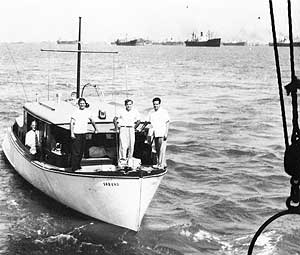
In 1946 Raydist gets its first shipboard experience—aboard a cabin cruiser owned by John Comstock, Mary Hastings' father. Charles Hastings (right) and two Raydist technicians stand on the bow. Comstock appears at far left.
|
M
eanwhile work continued on other projects, and Hastings laid the groundwork for uses of Raydist in other areas.
He had many ideas for commercial use of the Raydist equipment—such as in hydrography, oil exploration, and ship testing. All of these required using the equipment aboard ship. It became a top priority to get some experience using Raydist at sea. He knew that theoretically it should work on a ship, but it had never been tried.
Finding a boat to use was not difficult. Mary's father, John Comstock, had a cabin cruiser, the Almado, and he volunteered it for the experiments.
One day in the summer of 1946, Hastings and his crew installed a master station on the boat and set up two relay stations—one near Old Point Comfort and the other five miles away at Middleground Lighthouse.
With Comstock at the wheel, the Almado made half a dozen trips back and forth between the two stations while Hastings and his assistants worked with the Raydist. It took them several hours just to silence the interference from the boat's gasoline engine, but by the end of the day they were convinced that the system would work.
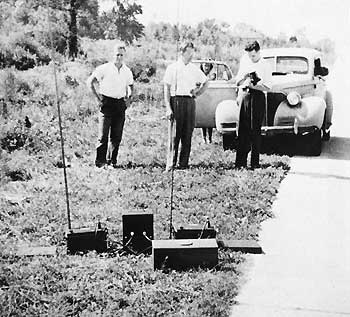
After the equipment for Wright Field has had its final testing, everyone celebrates by posing for photographs. With the equipment in the foreground, Ray Hansen, Andy Hacskaylo, and Charles Hastings (l-r) admire their handiwork.
|
I
n September the set for Wright Field was nearly complete. To calibrate it, Charles Hastings and Andy Hacskaylo put the equipment into the back of a car and drove out to Pembroke Avenue (then called Super Highway), armed with a 100-foot tape measure, a paint brush, and a can of white paint. They then proceeded to mark off a couple of miles of highway with white stripes every hundred feet. It was backbreaking and time-consuming, but it gave them the course they needed. And to their surprise no one ever questioned what they were doing painting marks on a public highway.
The set was ready for delivery in October. When Hastings found out how much it would cost to insure it for delivery to Wright Field, he decided he couldn't afford it. Besides, with no replacement available, he couldn't take the chance of something happening to it. So he and Hacskaylo agreed to drive the Raydist to Cleveland and deliver it in person.
As they loaded it into the station wagon, Hastings felt that success for his company was finally assured. "Mary," he said, "if only this equipment gets there safely and we get paid, all our troubles will be over."

At Wright Field, the Raydist equipment is installed in a helicopter for use in aerial photogrammetry.
|
next chapter >>
Copyright © by Carol Hastings Sanders
|
